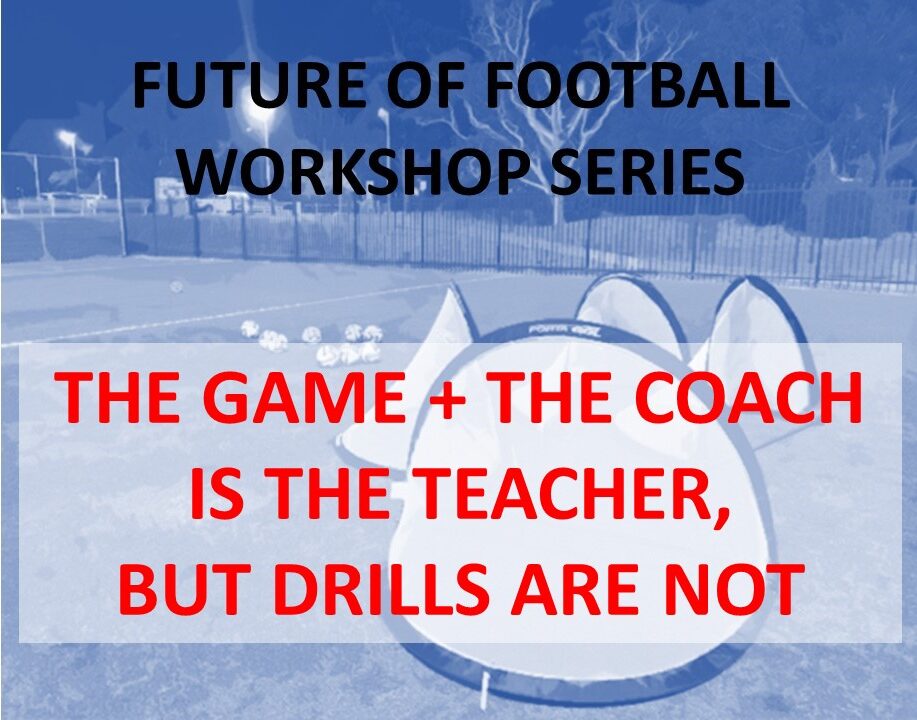MWFA recently ran a series of interactive and special workshops for coaches interested in where the future of football is heading, especially in youth development. There are people’s opinions, and there is logical debate, but sometimes even these are not enough for some people to be convinced. To resolve this dilemma, we conducted some football ‘experiments’ to prove how certain things should be approached using actual grassroots players, factual data and first hand experiences.
In this first workshop, the theme was: “THE GAME AND THE COACH IS THE TEACHER, BUT DRILLS ARE NOT”.
We had several groups, some being taught certain skills (passing or first touch) in a typical drill based sessions, game-like sessions and/or purely game-based sessions. Each session finished with a free 4v4 game to see how the learnings from earlier exercises would transfer into the most match realistic scenario.
The different types of training sessions were structured as follows:
- Drill-based included isolated and/or static passing exercises in straight lines or pre-determined routines
- Game-like included exercises with goals, space, opponents and teammates etc such as passing and moving freely, and 4v1/5v3 etc
- Game-based included various 4v4 exercises with different scoring systems, or variations with different numbers e.g. 2 games of 2v2 or 3v3 with 2 neutral players
We measured the following stats for players in each group across all 3 components of each session:
- Good first touches (moving into space)
- Bad first touches (stopped it dead or lost control)
- No first touches (could have but kicked it straight away and lost it)
OR
- One-touch successful passes
- Successful passes after taking one or more touches
- Failed attempted passes
AS WELL AS:
- Unprompted communication (asks for the ball, says “man-on” or “shoot” etc without being told to by the coach) in all sessions
We kept this experiment as objective and fair as possible by ensuring the following:
- We used both younger (U8-U10) and older (U11-U13) players across each training format
- Each group either participated in a drill-based session followed by a game-based one, or vice versa, or they did 2 x game-like sessions
- Every session had the same number of players, the same duration and used the same set up of equipment and size
- We had the same number of analysts watching each group in each session
Obviously, doing a longer term comparison would be better, but the results even from just one night were very insightful. Note that we were also able to calculate decision making opportunities by multiplying the number of total football actions per player by the number of decision making opportunities each exercise allowed for.
The raw data is shown in the following table:

What we can see is that the number of good passes and first touches was comparatively low in all game-based sessions (32.6 on average per player) compared to 76.3 in game-like sessions and 113.3 in drill based sessions. Obviously, isolated drills allow for higher repetition because they remove most or all other components of football to focus on those specific skills only. The number of bad first touches and passes was actually more even with game based having 30.1 per player, game-like 37 and drill-based 38.7.
Decision making opportunities were very different however. Game-based sessions allowed for 62.7 decisions per player on average, whereas game-like sessions had 150.3 decisions on average and drill-like sessions only had 23. Similar results were seen with unpromoted communication which was very low in drill-based sessions (average of 26 in total for all players in that entire session), whereas game-based was double at 51 for all players combined, and game-like was more than 7 times better at 188 for all players combined in that session. This means that although drill-based sessions allowed for higher repetition, they typically only allowed for repetition of a very small number of different actions with very few variables, whereas game-like and game-based sessions gave players a much wider variety of elements to be aware of and consider with each action they executed.
Conclusions / Reflections / Learnings:
- The clear winner from the 3 different approaches is ‘game-based’ training because it ticks both boxes – a high level of repetition can be achieved at the same time as realism (communication and decision making), which might be seen as a fundamental shift from the typical approach of the past, but it is important to understand that learning football skills is very different to something like gymnastics or golf because every football action involves considering various other players and options, which makes every pass different because the situation is always different
- Coaches should only resort to using drill-based exercises if they believe a player really needs to be able to focus on developing a specific skill they are struggling with, however be aware that this means you will slow down their development of communication and decision making – it is interesting to reflect on how much value we have placed on these aspects historically compared to technical qualities, because although strong technique is vital, if too much training is done in isolation, you cannot develop into a world-class communicator and decision maker, and perhaps this is something we need to get better at in this country
- Players can (and the more motivated ones should if they want to reach the highest level) also work on their technique in isolation at home against a wall for example, or at the park with friends, without this needing to take away a significant chunk of time from team training, because players also need to spend more time playing the game (to develop communication and decision making) given street football is not as popular as it used to be 20 years ago – coaches should also reflect on if the isolated drills they have used in the past were actually holding the players back because for the most part, they already could do technical work to a reasonable level in isolation, but actually needed to be challenged to execute it under pressure in more realistic scenarios (maybe even beginners can do more than you think they can)
MWFA would like to thank all of the players and coaches who participated in these workshops for their time and efforts.


